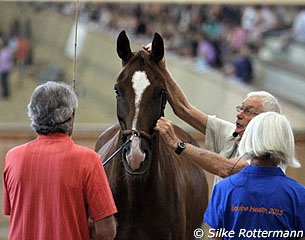
An extreme heatwave with temperatures nearing 40 degrees didn't deter almost 200 attendants, mostly equine professionals, from traveling to the idyllic Bavarian State Stud of Schwaiganger in the midst of the German Alps. Franco-American equine educational content specialist Caroline Larouillh in cooperation with her local organizer, German Verena Eiwen, produced the Symposium and brought together renowned US based Integrative Veterinary Medicine specialist Dr. Kerry Ridgway and Spanish-Australian dressage trainer Manolo Mendez on 4 - 5 July 2015.
This was the pair’s third two-day-symposium on equine health and performance since 2013.
On the first weekend of July, Upper Bavaria welcomed equine health professionals from 16 different countries under its cloudless blue sky. The remarkable combo of one of the USA's leading veterinarians and one of the foundation members of the Royal Andalusian School in Jerez de la Frontera who both aimed to show a holistic approach to optimizing horses' straightness, balance and performance drew numerous experts from all equine professions. They came to learn more about how to assess horses for laterality and other sports horse issues and the integrative veterinary medicine and in-hand, hands-on and training under saddle treatment and training options available to treat them holistically in accordance with classical dressage principles.
What seemed extraordinary was not just the fact that many different nationalities and horse professions were present at the symposium, but that people from different “dressage corners“ which sometimes observe each other more than just critically, met and got along quite nicely. On that weekend, followers of different “classical masters“ and high level dressage competitors were unified in their quest to learn more about how to improve their horses' well-being and level of performance.
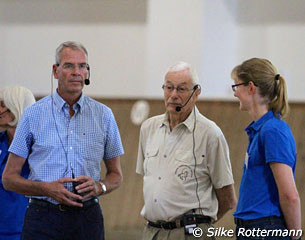 The event was opened by the long-time head of Schwaiganger, the former chief executive of the Trakehner breeding association in Neumünster, Dr. Eberhard Senckenberg. Despite being very busy managing the Bavarian Driving Championships which were held on the same weekend at his facility, the breeding expert took his time to welcome all to his charming and historical Stud. His introduction was followed by an easily understandable, but content-rich lecture by Dr. Kerry Ridgway on the topic of Laterality and Crookedness.
The event was opened by the long-time head of Schwaiganger, the former chief executive of the Trakehner breeding association in Neumünster, Dr. Eberhard Senckenberg. Despite being very busy managing the Bavarian Driving Championships which were held on the same weekend at his facility, the breeding expert took his time to welcome all to his charming and historical Stud. His introduction was followed by an easily understandable, but content-rich lecture by Dr. Kerry Ridgway on the topic of Laterality and Crookedness.
Dr. Ridgway put up the thesis that asymmetry is caused by laterality (dominance of one diagonal pairing) and is expressed as crookedness. As such, laterality is the key to the performance of the horse, good or bad. To correct this inborn crookedness in a systematic and sensible way is the main goal of equitation and the only way to keep horses as sound and as performance-capable as possible.
Ridgway demonstrated that a left- or right-forelimb dominance can easily be observed when watching horses graze. He quoted Klaus Schöneich’s assessment that 75-80% of all horses have a right-forelimb-dominance and explained that laterality of either the left or right forelimb naturally also impacts the horse’s hindquarters and pelvis and thereby the balance of the whole horse.
Factors such as individual conformation, injuries or degenerative joint diseases make matters even more complicated. It is common knowledge that a horse is born with more weight on his forehand and that the goal of training is to initially redistribute the weight more evenly and eventually in collected work have the weight more in the hind limbs, to allow the horse to carry the rider without injury to himself. From a veterinarian's point of view this happens through strengthening the core abdominal muscles and creating an upward swing in the back to allow throughness of the hindquarters. Dr. Ridgway warned that if training is not aiming towards strengthening, straightening, suppling and improving the horse’s balance and is not succeeding in making the horse more agile and coordinated in its movements through persistently overcoming laterality, then the horse will be prone to injury and others issues caused by natural crookedness. These includealtered hoof balance (manifested in the infamous high heel / low heel syndrome), an altered way of going and shortened strides on the dominant limb.
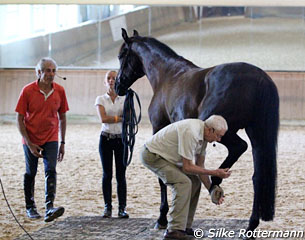 By implication only classical training and correct riding and in-hand work enables the horse to come into balance and to enjoy a longer pain-free life and less injuries. As a consequence, anyone dealing with horses in any way should accumulate as much knowledge as possible about these interrelations to avoid as much as possible the negative effects laterality causes when horses are ridden. But however hard one tries, and however significant one’s knowledge and experience, keeping a horse straight and balanced is a never ending effort - a striving for perfection which naturally doesn't exist.
By implication only classical training and correct riding and in-hand work enables the horse to come into balance and to enjoy a longer pain-free life and less injuries. As a consequence, anyone dealing with horses in any way should accumulate as much knowledge as possible about these interrelations to avoid as much as possible the negative effects laterality causes when horses are ridden. But however hard one tries, and however significant one’s knowledge and experience, keeping a horse straight and balanced is a never ending effort - a striving for perfection which naturally doesn't exist.
To illustrate the problems of laterality and more in sports horses, a thorough examination to find the achilles' heels of each of the case horses took place by Dr. Ridgway together with Manolo Mendez.
Dr. Ridgway commented several times during the Symposium on Manolo Mendez’s extensive knowledge of horses soundness, his unique ability to work with fascia and influence posture to improve horse’s health in-hand, through bodywork or under saddle and his ability to identify even the most subtle problems through a very keen sense of observation. Dr. Ridgway indicated that this kind of collaboration between veterinarian and trainer exemplifies the teamwork that should take place in the care of every horse, sports horse or not, between vets, trainers, owners, farriers, saddle fitter, therapists and more.
Both men first observed the horses being presented a few minutes under saddle before the rider had to lead the horse in a cavesson and a lunge line back and forth to both gentlemen so that the audience could learn how to assess movement and gait regularity by watching the horses walk and trot away and back.
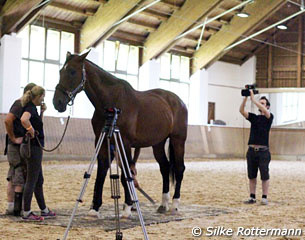 Dr. Ridgway’s acupuncture assessment protocol was done very systematically and meticulously. “He started with the pterygoids, hyoid reactivity bilaterally and TMJ assessment, then moved onto the poll and checked between each cervical vertebrae for a pain response. He then checked the neck muscles, over the C1-C2 area,brachiocephalicus, down the splenius, cervical and thoracic rhomboids, subclavian, infraspinatus, deltoids, rib shelf and wither pocket and triceps leading into the elbow. This was followed by checking the girth area muscles; latissimus dorsi, serratus ventralis thoracis and ascending pectoralis. That was the front end exam and it continued just as thoroughly for the back end“, Dr. Mead, Dr. Ridgway's assistant vet, explained to Eurodressage.
During the assessment, as well as during the treatment with bodywork and acupuncture later on, the audience was able to follow as each check was explained clearly and a professional camera-man filmed close-ups which were projected on a big screen in the indoor arena.
Dr. Ridgway’s acupuncture assessment protocol was done very systematically and meticulously. “He started with the pterygoids, hyoid reactivity bilaterally and TMJ assessment, then moved onto the poll and checked between each cervical vertebrae for a pain response. He then checked the neck muscles, over the C1-C2 area,brachiocephalicus, down the splenius, cervical and thoracic rhomboids, subclavian, infraspinatus, deltoids, rib shelf and wither pocket and triceps leading into the elbow. This was followed by checking the girth area muscles; latissimus dorsi, serratus ventralis thoracis and ascending pectoralis. That was the front end exam and it continued just as thoroughly for the back end“, Dr. Mead, Dr. Ridgway's assistant vet, explained to Eurodressage.
During the assessment, as well as during the treatment with bodywork and acupuncture later on, the audience was able to follow as each check was explained clearly and a professional camera-man filmed close-ups which were projected on a big screen in the indoor arena.
Among the five featured horses, two were advanced dressage horses who are regularly competed up to Inter I- level with two of them on their way to Grand Prix. Additionally a 9-year-old currently at M-level dressage was presented. They each represented different physical problems which manifested in training difficulties. For example having difficulties bending to one side in the lateral work and losing the fluidity of movement or having irregularities in the trot extensions, having difficulties executing flying changes or pirouettes or pacing in the walk. Additionally all three horses had some conformation issues which added to their troubles such as a tendency to have the hind-legs out behind, being a little croup-high or having a long back within a huge frame. It was interesting to hear the explanation from a veterinarian point of view for problems the riders had described earlier. For example that an insufficient extended trot can have its cause in underdeveloped biceps femoral muscles and an excessive flexion of the pelvis, accompanied by being tight in the triceps and tense behind the elbow.
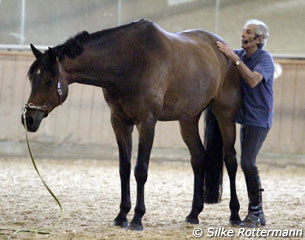 Manolo Mendez treated this horse by working him in-hand, asking for lateral neck flexions, a lowering of the head and bilateral-poll-neck-release to free the horse's neck movement and to get more thoroughness coming from behind. Mendez stressed that while working horses laterally it is of uppermost importance that this happens on three and never on four tracks as the latter causes a disconnection between front- and hind-end. Lateral movements are just one component of his approach and must not be done excessively. Walking straight, soft bended lines, stepping back and turning are equally important in his system.
Manolo Mendez treated this horse by working him in-hand, asking for lateral neck flexions, a lowering of the head and bilateral-poll-neck-release to free the horse's neck movement and to get more thoroughness coming from behind. Mendez stressed that while working horses laterally it is of uppermost importance that this happens on three and never on four tracks as the latter causes a disconnection between front- and hind-end. Lateral movements are just one component of his approach and must not be done excessively. Walking straight, soft bended lines, stepping back and turning are equally important in his system.
Dr. Ridgway, assisted by Dr. Mead, a young veterinarian surgeon who had flown in from New Zealand for the symposium, treated the horses by acupuncture in order to release fascial restrictions and muscular hypertension. As the extremely experienced veterinarian, who was inducted in the Hall of Fame of Endurance sport in the USA in 1990, later lectured, the fascial system of a horse's body has extensive influence of the latter, because every muscle fibre is wrapped in fascia, which also surrounds blood vessels and nerves and fills space between muscle groups. In addition, ligaments and tendons also consist of a type of fascia. The skeleton is covered by what are called “fascial trains” which means that if one part of a fascial train is needled, the whole system (which one can visualize like a spider-net), is affected. So one can treat a part of the body away from the spot which is the problem and still achieve an effect.
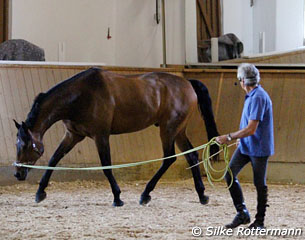 Manolo Mendez influenced the fascial system his way by working the horses in hand and changing the posture and horse's way of going. He paid particular attention to the mental and emotional state of the horse and how it used its whole body with particular attention placed on how it was moving its head, neck and back and how regular or not, how symmetric or not its musculoskeletal mass and movements were. This kind of work was extremely interesting to watch. With the help of one of his long, very thin and dry bamboo canes he gently touched the horses at the right moment on different parts of their bodies to change their posture, to awake or sooth, to slow down or activate, to encourage more or less flexion or ask a leg to step more or less underneath the body, etc.. The horses' responses were amazing. For example a strongly pacing gelding came back to a clear walk in a short time, others became visibly freer in their movement in a few moments as they begun to trust Manolo, relax and focus on the work.
Manolo Mendez influenced the fascial system his way by working the horses in hand and changing the posture and horse's way of going. He paid particular attention to the mental and emotional state of the horse and how it used its whole body with particular attention placed on how it was moving its head, neck and back and how regular or not, how symmetric or not its musculoskeletal mass and movements were. This kind of work was extremely interesting to watch. With the help of one of his long, very thin and dry bamboo canes he gently touched the horses at the right moment on different parts of their bodies to change their posture, to awake or sooth, to slow down or activate, to encourage more or less flexion or ask a leg to step more or less underneath the body, etc.. The horses' responses were amazing. For example a strongly pacing gelding came back to a clear walk in a short time, others became visibly freer in their movement in a few moments as they begun to trust Manolo, relax and focus on the work.
Apart from treating visible physical problems it was pretty impressive to see how quickly one of the three horses which entered the arena completely anxious and spooking and not paying much attention to her owner, calmed down quickly when Manolo Mendez took over.
Using his clear and quiet body language along with one of his bamboo sticks to give light cues the leggy Spaniard who is based in Australia nowadays helped the horse become calm and confident.
Manolo’s deep respect and affection for each horse he worked with was almost palpable for the audience and was something which left a lasting impression, apart from his undoubtedly high training and riding skills.
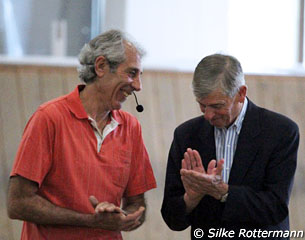 Day two started with two lectures which the audience followed with outstanding interest and discipline. Former head rider of the Cadre Noir and retired I-judge Colonel Carde from France who was invited to to attend the symposium as its guest of honour, focused on the topic of balance from the rider's, trainer's and judge's viewpoint. He highlighted that a kind of quadruple balance of horse and rider is in need:
the mental and physical balance which the horse only achieves if he carries a rider in that state. The credo of France's legendary riding master of the 19th century, Alexis L'Hotte, of “calmness, activity and straightness” is the key to balance.
Day two started with two lectures which the audience followed with outstanding interest and discipline. Former head rider of the Cadre Noir and retired I-judge Colonel Carde from France who was invited to to attend the symposium as its guest of honour, focused on the topic of balance from the rider's, trainer's and judge's viewpoint. He highlighted that a kind of quadruple balance of horse and rider is in need:
the mental and physical balance which the horse only achieves if he carries a rider in that state. The credo of France's legendary riding master of the 19th century, Alexis L'Hotte, of “calmness, activity and straightness” is the key to balance.
Carde made the audience aware that achieving balance is also a balancing-act in itself, because “too much or too little engagement of the hindquarters or contact with the bit will always oppose a horse's balance and muscular harmony.” The term of muscular harmony thereby describes the state of balance that can only exist when all the muscles and joints of a horse work easily together as a result of the horse being straight and supple.
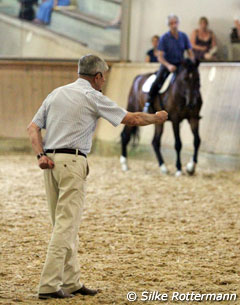 While the outspoken rollkur-opponent had no problem illustrating his presentation with well-known international Grand Prix-riders representing a classical approach of equitation, he still put the finger in the wound by asking if a horse in muscular harmony, presented with a light contact and with self-carriage as required by the FEI dressage rules, is still represented sufficiently in international dressage competitions. It became obvious that this was nothing more than a rhetoric question when he showed a medal decorated horse with a disconnected extended trot and an invitation for a French CDI-show in July on which a tense over bent horse was shown in the same movement.
While the outspoken rollkur-opponent had no problem illustrating his presentation with well-known international Grand Prix-riders representing a classical approach of equitation, he still put the finger in the wound by asking if a horse in muscular harmony, presented with a light contact and with self-carriage as required by the FEI dressage rules, is still represented sufficiently in international dressage competitions. It became obvious that this was nothing more than a rhetoric question when he showed a medal decorated horse with a disconnected extended trot and an invitation for a French CDI-show in July on which a tense over bent horse was shown in the same movement.
Carde stated that “correct riding is simply sometimes not spectacular looking“, indicating that the spectators' wish for the spectacular and the judges' willingness to honor it has taken an undesirable effect on dressage sport.
In a way, Dr. Ridgway took up on Colonel Carde's focus on achieving muscular harmony through correct training by lecturing on the rehabilitation of soft tissue fascia which so far seems rather underestimated in the public awareness compared to other things a horse can suffer from. According to Dr. Ridgway 15-18% of horses used in sport get a soft tissue injury each year, probably as a result of the fact that “many horses have to place tremendous strain on the musculoskeletal system from a very young age, putting the tendons and ligaments on breaking strain.“
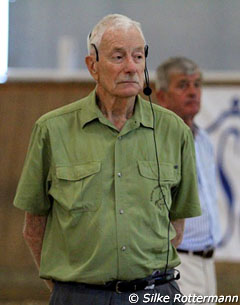 The over 80-year-old vet reminded everybody in the Schwaiganger indoor arena that joints, tendons and ligaments—the focus of most vets' examination and treatment—function only thanks to fascia and muscles. Dr. Ridgway quite rightfully posed the question “Are we not treating the branch rather than the root like that?” He brought up as an example that tendon injuries are often a result of muscle-fatigue.
The over 80-year-old vet reminded everybody in the Schwaiganger indoor arena that joints, tendons and ligaments—the focus of most vets' examination and treatment—function only thanks to fascia and muscles. Dr. Ridgway quite rightfully posed the question “Are we not treating the branch rather than the root like that?” He brought up as an example that tendon injuries are often a result of muscle-fatigue.
The problem of soft tissue injuries is that they are a consequence of repeated strain rather than being due to traumatic causes. They often reveal themselves only in after a short lameness, but have an ever-lasting ability to to interfere with a horse’s performance capability if they remain untreated.
Ridgway dispelled the myth that turn-out or stall-rest are suitable for a proper and lasting rehabilitation. Less than one third of the horses which appeared in a British study stayed sound when turned out for several months after a 2-months-stall-rest and being taken back into full work afterwards.
Instead he recommended doing the kind of in-hand work Manolo Mendez practices. Progressive and careful in-hand-work to re-condition the horse, optimize its suppleness, straightness and balance to minimize its laterality and reduce the risk of re-injury. But eliminating or reducing strongly the risk of re-injury depends on a whole horse approach to treatment. Ideally combining alternative and conventional medicine, and above all identifying and removing the original cause for the injury which can stem from poor foot balance, poor saddle-fitting and training programs and arduous competition schedules. Throughout the two days the audience regularly had the opportunity to ask questions about what they had just seen or ask any other question regarding equine health to the experts. The Symposium’s format also encouraged attendants to observe the horses and share their observations with Dr. Ridgway and Manolo Mendez. Due to the friendly and open minded atmosphere fostered by the organizer Caroline Larouilh who acted as a moderator, a lively exchange of questions and ideas developed which was appreciated by everyone.
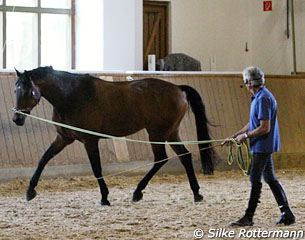 Two days of intense learning closed Sunday early evening with Manolo Mendez riding the huge KWPN gelding Supertramp, an Inter I-horse and demonstrating how to straighten, supple and balance a horse under saddle as a continuation of the bodywork and in-hand work necessary to remedy laterality or other sports horse issues.
Two days of intense learning closed Sunday early evening with Manolo Mendez riding the huge KWPN gelding Supertramp, an Inter I-horse and demonstrating how to straighten, supple and balance a horse under saddle as a continuation of the bodywork and in-hand work necessary to remedy laterality or other sports horse issues.
The audience watched and listened in awe as Colonel Carde took the microphone and gave everyone present a flawless dressage lesson by explaining clearly the purpose of each exercise and movement Manolo Mendez chose as he gently and progressively prepared Supertramp and schooled the shoulder in, travers, half-pass, learning pirouette and a little piaffe very simply in a snaffle without any stress or tension. The Frenchman took this position with a twinkle in his eye, commenting that “I take the microphone now because I am very fond of helping young riders. And if you continue riding like that, Manolo, you will become a very good rider.“ This was met by general laughter.
Col. Carde later stated that there was nothing to add to what Manolo had shown. He indicated that while this kind of riding is not popular with judges, it nevertheless meets the very definition of the Dressage Rules and is as Dressage should be, as the horse is present and ready to respond willingly to every one of the rider’s requests.
The softness and lightness Mendez achieved with this huge horse who was successfully treated for his foot balance issues and unilateral hock instability when Manolo trimmed his hind feet earlier in the day was the best proof of how beautiful a horse in balance, physically and mentally can perform - to use the FEI terminology Supertramp showed exactly what a “happy athlete”should look like.
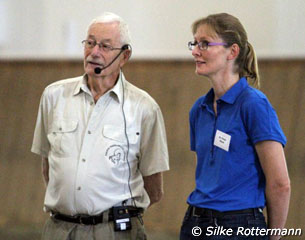 Perhaps the most important thing the symposium made everyone present aware of is that to truly optimize a horse's performance there needs to a concerted, best effort from all the people involved with the horse’s care. Because if one aspect of a horse’s care and management is failing, it will badly affect all the other aspects. Only a holistic team approach to each individual horse can ensure it will achieve the best within his possibilities.
Perhaps the most important thing the symposium made everyone present aware of is that to truly optimize a horse's performance there needs to a concerted, best effort from all the people involved with the horse’s care. Because if one aspect of a horse’s care and management is failing, it will badly affect all the other aspects. Only a holistic team approach to each individual horse can ensure it will achieve the best within his possibilities.
Text by Silke Rottermann/Dr. Mead and Photos © Silke Rottermann for Eurodressage
Related Links
Symposium With Manolo Mendez and Dr. Ridgway in Germany: Optimizing Horses' Straightness, Balance and Performance
Manolo Mendez and Kerry Ridgway Symposium in California: Optimizing Your Horse's Straightness, Balance and Performance
Christian Carde: The Poll as Highest Point, Is it Still a Necessity?
Christian Carde: Where Did the Halt Go?
Christian Carde Clinic in Finland: "Good Riding is Good Riding"